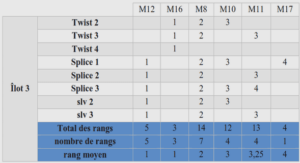Données complémentaires sur l’evolution de la conductivité des effluents de colonnes de sol non remanié durant le drainage
Ces données sont rattachées au chapitre IV et permettent de constater l’effet de l’infiltration de l’eau de pluie – de faible conductivité ionique (environ 17 µS cm-1) – sur la conductivité des effluents récupérés durant le drainage (colonnes 1, 2 et 3). Un effet de dilution est constaté durant toute la durée de la pluie, puis la conductivité remonte rapidement après son arrêt pour retrouver des valeurs proches de la conductivité initiale. les pluies. Les effluents sont récupérés en sortie de colonne de luvisol non remanié. Les propriétés de ce sol sont décrites Tableau II-1 et dans le chapitre IV traitant de la rétention de microsphères. Cette annexe présente une activité complémentaire de recherche, menée durant cette thèse, dont les résultats, complexes à interpréter, n’ont pas pu être inclus dans le présent manuscrit et durant le temps imparti. Il s’est agit de localiser par micro-diffraction des rayons X sur source synchrotron des revêtements supposés s’être formés durant des expérimentations de pluies sur colonnes de sol non remanié (Quénard, 2011) et supposés enrichis en smectite. Lessivage is among the most widespread processes in soils and it has been described in many soils types (WRB, 2006). This process is defined as a substantial vertical transfer of fine particles (with size ranging from less than 2 µm to less than 10 µm according to different authors) from a horizon, called eluviated horizon to another horizon referred to illuviated horizon (Legros, 2007). Physical and chemico-physical mechanisms involved in this process are not yet fully understood and lessivage fluxes are still not quantified due to obvious technical difficulties. The Agriped project started end of 2010 has been funded by the ANR to identify the mechanisms responsible for lessivage, quantify and model it. Within the frame of this project a complex experimental setup was build up in order to simulate lessivage in lab (i.e. simulation on a sequence of rainfall events) and to identify the processes and factors responsible for it.
The lab experiment setup consists in a sequence of 30 rainfalls on undisturbed and unsaturated soil columns of decimeter size. In order to simulate separately eluviation and illuviation two experiments were run. As smectite were described as especially sensitive to eluviation (Mercier et al., 2000), the first experiment designed to simulate eluviation consisted in columns made of an undisturbed soil monolith containing smectite. The second experiment, designed to simulate illuviation, consisted in columns made of two overlaid soil monoliths, the upper one being that used for the eluviation experiment and lower-one containing no smectite. and were partially (25 to 90 %) fixed in the lower horizon. About 50 g m2 particles were fixated within the 15 cm depth of the lower soil monoliths. This fixation was shown to be due to physico-chemical processes during the first 17 rains and to column clogging on the rest of the experiment (Cornu et al., 2014). However the origin and the location within the lower soil monolith of the clogging could not be identified. Clogging could be either due to the collapse of the soil structure within the column or to the closure of pores by illuviation (particle fixation). To answer this question the lower soil monolith have to be open and analysed. Therefore thin sections were made on these monoliths for different amounts of rain and different rainfall intensities. On these sections, clay coatings were identified along pores and their geometrical relationship to the porosity described. However, the coatings may have pre-existed the experiment. Differentiating old from new coating by optical microscopy is feasible but only in very well developed clay coatings, which is probably not our case (Akamigbo and Dalrymple, 1985). Mapping the mineralogical composition of the clay coating would allow distinguishing with certainty the new coatings thanks to the presence of smectite. The clay coatings in soils are generally of 60 to 200 µm thick (Dalrymple and Theocharopoulos, 1987; Thompson et al., 1990), but they are developed on longer time period. Therefore the coatings build up over the experiment are more probably 20 to 30 µm thick. For this reason, analysing them with a lab-DRX is not possible as the beam obtained on this type of apparatus is about 150 µm in size.



